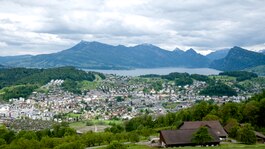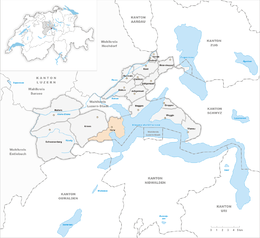Horw
| Horw | ||
|---|---|---|
 |
||
|
||
| Coordinates: 47°1′N 8°19′E / 47.017°N 8.317°ECoordinates: 47°1′N 8°19′E / 47.017°N 8.317°E | ||
| Country | Switzerland | |
| Canton | Lucerne | |
| District | Lucerne | |
| Government | ||
| • Executive |
Gemeinderat with 5 members |
|
| • Mayor | Gemeindepräsident | |
| • Parliament |
Einwohnerrat with 30 members |
|
| Area | ||
| • Total | 12.84 km2 (4.96 sq mi) | |
| Elevation | 441 m (1,447 ft) | |
| Population (Dec 2015) | ||
| • Total | 13,788 | |
| • Density | 1,100/km2 (2,800/sq mi) | |
| Postal code | 6048 | |
| SFOS number | 1058 | |
| Surrounded by | Hergiswil (NW), Kriens, Lucerne (Luzern), Meggen, Stansstad (NW) | |
| Twin towns | Bratsch (Switzerland) | |
| Website |
www Profile (German), SFSO statistics |
|
Horw (German pronunciation: [hɔʁv]; Swiss German: Horb) is a municipality in the district of Lucerne in the canton of Lucerne in Switzerland.
Horw is first mentioned in 1231 as Horwe.
Horw has an area of 12.8 km2 (4.9 sq mi). Of this area, 32.6% is used for agricultural purposes, while 42.5% is forested. Of the rest of the land, 24.2% is settled (buildings or roads) and the remainder (0.7%) is non-productive (rivers, glaciers or mountains). In the 1997 land survey[update], 42.42% of the total land area was forested. Of the agricultural land, 30.54% is used for farming or pastures, while 1.94% is used for orchards or vine crops. Of the settled areas, 14.61% is covered with buildings, 1.01% is industrial, 1.09% is classed as special developments, 1.79% is parks or greenbelts and 5.59% is transportation infrastructure. Of the unproductive areas, 0.39% is unproductive standing water (ponds or lakes), 0.08% is unproductive flowing water (rivers) and 0.54% is other unproductive land.
The municipality is located on the outskirts of Lucerne on the Horwer peninsula. It covers the base of Mt. Pilatus and the, until the 20th Century swampy, valley below the mountain.
Horw has a population (as of 31 December 2015) of 13,788. As of 2007[update], 16.2% of the population was made up of foreign nationals. Over the last 10 years the population has grown at a rate of 8.8%. Most of the population (as of 2000[update]) speaks German (86.5%), with Italian being second most common ( 2.3%) and Serbo-Croatian being third ( 2.0%).
...
Wikipedia



